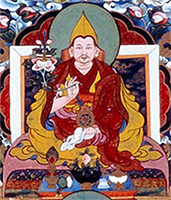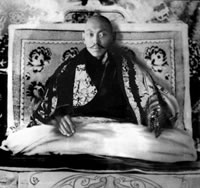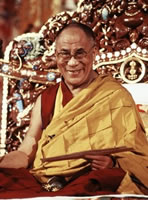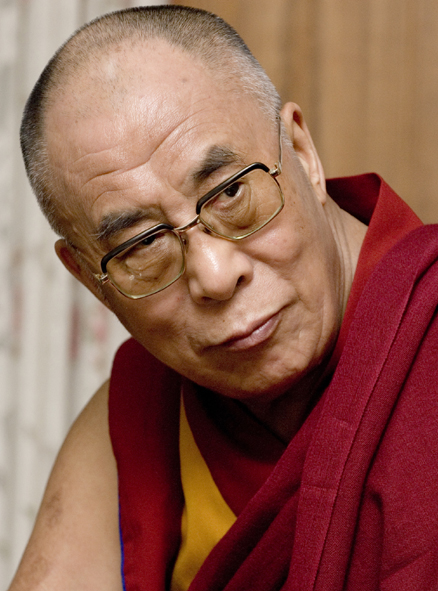Questioning the Advice of the Guru
by H.H. the XIV. Dalai Lama, Tenzin Gyatso
- The Dalai Lamas – About
- The Dalai Lama in Global Perspective
- 5th Dalai Lama, Ngawang Lobsang Gyatso — About
- 5th Dalai Lama, Ngawang Lobsang Gyatso — Opinion on His Rule
- 13th Dalai Lama, Thubten Gyatso – About
- 13th Dalai Lama, Thubten Gyatso – Opinion on His Rule
- 14th Dalai Lama – About
- 14th Dalai Lama – His Accomplishments
- HHDL
The XIVth Dalai Lama, Tenzin Gyatso.
© www.dalailama.com - printable4_fs
The XIVth Dalai Lama, Tenzin Gyatso.
© www.dalailama.com - printable1_fs
The XIVth Dalai Lama, Tenzin Gyatso.
© www.dalailama.com - printable9_fs
The XIVth Dalai Lama, Tenzin Gyatso.
© www.dalailama.com - printable6_fs
The XIVth Dalai Lama, Tenzin Gyatso.
© Tenzin Jamphel / OHHDL. Details: Official Dalai Lama Facebook Site - printable8_fs
The XIVth Dalai Lama, Tenzin Gyatso.
© www.dalailama.com - printable7_fs
The XIVth Dalai Lama, Tenzin Gyatso.
© www.dalailama.com
The Dalai Lamas
“The Dalai Lamas are held by their followers to be advanced Mahayana bodhisattvas that is compassionate beings who so to speak have postponed their own entry into nirvana to help suffering humanity. Thus they are thought to be well on the way to Buddhahood, developing perfection in wisdom and compassion for the benefit of all sentient beings. It is this that justifies doctrinally the socio-political involvement of the Dalai Lamas, as an expression of a bodhisattva’s compassionate wish to help others.”
“We should note here two things a Dalai Lama is not. First, he is not in any simple sense a ‘god-king’. He may be a sort of king, but he is not for Buddhism a god. Second, the Dalai Lama is not the ‘head of Tibetan Buddhism’, let alone of Buddhism as a whole. There are many traditions of Buddhism. Some have nominated ‘Heads’; some do not. Within Tibet too there are a number of traditions. The Head of the Geluk tradtion is whoever is abbot of Ganden monastery, in succession to Tsong kha pa, the fourteenth/fifteenth century Geluk founder.”
Paul Williams, “Dalai Lama”, in Clarke, P. B., Encyclopedia of New Religious Movements, (New York: Routledge, 2006), p. 136.
The Dalai Lama in Global Perspective
“Westerners who study the system of reincarnating lamas are often understandably skeptical about it, but it seems clear that somehow the Tibetans who choose the Dalai Lamas have managed to find a remarkable succession of unusually gifted people. Even given the profound devotion that Tibetans feel for their Dalai Lamas, it would be difficult to disguise an incarnation who was stupid, arrogant, greedy, or belligerent. Those Dalai Lamas who attained maturity, however, have consistently distinguished themselves in their teaching, writing, and their personal examples. The present Dalai Lama is a testament to the success of the system through which Dalai Lamas are found, and it is improbable that his remarkable Accomplishments are merely due to good training. Many monks follow the same basic training as the Dalai Lamas, but somehow the Dalai Lamas tend to rise above others of their generation in terms of scholarship, personal meditative attainments, and teaching abilities. It is true that they receive the best training, and they also have the finest teachers, but these facts alone fail to account for their accomplishments. In Western countries, many students enroll in the finest colleges, study with the best teachers, and still fail to rise above mediocrity because they are lacking in intellectual gifts.”
“There are obviously problems with the system, particularly the problem of lapses of leadership while newly recognized Dalai Lamas reach maturity. The system worked well enough in the past when Tibet was not beset by hostile neighbors, but it is difficult to imagine any country in the present age being able to endure periods of eighteen years or more without a true leader. It is not surprising, therefore, that the present Dalai Lama has expressed doubts about the continuing viability of the institution of the Dalai Lamas and has indicated that he may not choose to reincarnate. He has also proposed that the office of Dalai Lama become an elected position, with the Tibetan people voting for their spiritual leader. The Dalai Lama appears to recognize the flaws in the present system and apparently hopes that the institution will be adapted to changing times.”
John Powers, “Introduction to Tibetan Buddhism”, Snow Lion Publications, 1995, pp. 186–87.
The Fifth Dalai Lama, Ngawang Lobsang Gyatso (1617–1682)

“The 5th Dalai Lama, known to Tibetan history simply as the ‘Great Fifth,’ is renowned as the leader under whom Tibet was unified in 1642 in the wake of bitter civil war. The era of the 5th Dalai Lama—roughly the period from his enthronement as leader of Tibet in 1642 to the dawn of the 18th century, when his government began to lose control—was the formative moment in the creation of a Tibetan national identity, an identity centered in large part upon the Dalai Lama, the Potala Palace of the Dalai Lamas, and the holy temples of Lhasa. During this era the Dalai Lama was transformed from an ordinary incarnation among the many associated with particular Buddhist schools into the protector of the country. In 1646 one writer could say that, due to the good works of the 5th Dalai Lama, the whole of Tibet was now centered under a white parasol of benevolent protection. And in 1698 another writer could say that the Dalai Lama’s government serves Tibet just as a bodhisattva—that saintly hero of Mahayana Buddhism—serves all of humanity.”
Kurtis R. Schaeffer, “The Fifth Dalai Lama Ngawang Lopsang Gyatso”, in The Dalai Lamas: A Visual History, Serinda Publications, Edited by Martin Brauen, 2005, p. 65.
The Fifth Dalai Lama: Opinion on His Rule
“By most accounts the [5th] Dalai Lama was by the standards of his age a reasonably tolerant and benevolent ruler.”
Paul Williams, “Dalai Lama”, in (Clarke, 2006, p. 136).
“The fifth Dalai Lama, Ngawang Losang Gyatso (1617–1682), popularly referred to as ‘The Great Fifth,’ was the most dynamic and influential of the early Dalai Lamas. He was a great teacher, an accomplished tantric yogin, and a prodigious writer. His literary output surpasses the combined total of all the other Dalai Lamas. In addition to his scholastic achievements, he proved to be an able statesman, and he united the three provinces of Tibet (the Central, South, and West) for the first time since the assassination of king Lang Darma in the mid-ninth century.”
“Although he was rather heavy-handed with the Jonangpas and the Karmapas, his treatment of other orders was often generous. He was particularly supportive of Nyingma, and he himself was an ardent practitioner of several Nyingma tantric lineages. Snellgrove and Richardson contend that on the whole his actions proved to be beneficial and stabilizing, despite the obvious hard feelings they engendered among his opponents:
‘The older orders may preserve some bitter memories of the fifth Dalai Lama, for no one likes a diminution of wealth and power, but there is no doubt that without his moderating and controlling hand, their lot might have been very much worse. It must also be said that at that time, despite their new political interests and responsibilities, the dGe-lugs-pas remained the freshest and most zealous of the Tibetan religious orders.’” (Snellgrove & Richardson, A Cultural History of Tibet, p. 197)
(Powers 1995: 145,146–47)
More about the Fifth Dalai Lama
- “The Fifth Dalai Lama and his Reunification of Tibet” by Samten G. Karmay
- “The Great Fifth” by Samten G. Karmay
The Thirteenth Dalai Lama, Thubten Gyatso (1876–1933)

“The other Dalai Lama who was particularly important was the Thirteenth (1876–1933). A strong ruler he tried, generally unsuccessfully, to modernize Tibet. The ‘Great Thirteenth’ also took advantage of weakening Chinese influence in the wake of the 1911 imperial collapse to reassert de facto what Tibetans have always considered to be truly the case, the complete independence of Tibet as a nation from China.”
Paul Williams, “Dalai Lama” in (Clarke, 2006, p. 137).
“Some may ask how the Dalai Lama’s rule compared with that of rulers in European or American countries. But such a comparison would not be fair, unless applied to the Europe of several hundred years ago, when it was still in the same stage of feudal development that Tibet is in at the present day. Certain it is that Tibetans would not be happy if they were governed as people are in England; and it is probable that they are on the whole happier than are people in Europe or America under their own governments. Great changes will come in time; but unless they come slowly, when the people are ready to assimilate them, they will cause great unhappiness. Meanwhile, the general administration in Tibet is more orderly than the administration in China; the Tibetan standard of living is higher than the standard in China or India; and the status of women in Tibet is higher than their status in either of those two large countries.”
Sir Charles Bell, “Portrait of a Dalai Lama: The Life and Times of the Great Thirteenth”, Wisdom Publications, 1987, pp. 443–444.
The Thirteenth Dalai Lama: Opinion on His Rule
“Was the Dalai Lama on the whole a good ruler? We may safely say that he was, on the spiritual as well as the secular side. As for the former, he had studied the complicated structure of Tibetan Buddhism with exceptional energy when a boy, and had become exceptionally learned in it. He improved the standard of the monks, made them keep up their studies, checked greed, laziness and bribery among them, and diminished their interference in politics. He took care of the innumerable religious buildings as far as possible. On the whole it must certainly be said that he increased the spirituality of Tibetan Buddhism.
“On the secular side he improved law and order, increased his own contact with his people, introduced more merciful standards into the administration of justice and, as stated above, lessened monastic domination in secular affairs. In the hope of preventing Chinese invasions he built up an army in the face of opposition from the monasteries; prior to his rule there was practically no army at all. In view of the extreme stringency of Tibetan finance, the intense monastic opposition and other difficulties, he could have gone no farther than he did.
“During his reign the Dalai Lama abolished Chinese domination entirely throughout the large part of Tibet governed by him, excluding Chinese officials and soldiers. That portion of Tibet became a completely independent kingdom, and remained independent during the last twenty years of his life.”
Sir Charles Bell in (Bell 1987: 444).
More about the Thirteenth Dalai Lama
- “The Thirteenth Dalai Lama, Tubten Gyatso” by Tsering Shakya
The Fourteenth Dalai Lama, Tenzin Gyatso

“The current Fourteenth Dalai Lama (Tenzin Gyatso) was born in 1935. The Chinese invaded Tibet in the early 1950s and the Dalai Lama left Tibet in 1959. He now lives as a refugee in Dharamsala, North India, where he presides over the Tibetan Government in Exile. A learned and charismatic figure, he has been active in promoting the cause of his country’s independence from China. He also promulgates Buddhism, world peace, and research into Buddhism and science, through his frequent travels, teaching, and books. Advocating ‘universal responsibility and a good heart’, he was awarded the Nobel Peace Prize in 1989.”
Paul Williams, “Dalai Lama”, in (Clarke, 2006, p. 137).
Biography
The Fourteenth Dalai Lama: His Accomplishments
“When one considers the origins of the present Dalai Lama, his successes are remarkable. Born in a remote village in eastern Tibet, driven from his country by an invading army and forced to start over in exile, he is today a Nobel Prize laureate and one of the world’s most revered religious leaders. When one considers the odds against randomly choosing a young child from a remote Tibetan village, educating him in a traditional Tibetan monastic curriculum, and his later winning the Nobel Peace Prize, his successes might give skeptics pause. As Glenn Mullin remarks of the fourteenth Dalai Lama,
‘the depth of his learning, wisdom and profound insight into the nature of human existence has won him hundreds of thousands of friends around the world. His humor, warmth and compassionate energy stand as living evidence of the strength and efficacy of Tibetan Buddhism, and of its value to human society.’” (Mullin, Glenn, Selected Works of the Dalai Lama II, 1982, p. 220)
(Powers 1995: 187)
You should do everything your guru tells you to do, even if it seems strange, right? Wrong. According to His Holiness the Dalai Lama every student is responsible for checking the guru’s instructions against reason and Dharma. The rationalizations that many students tell themselves in the face of odd guru behaviours – “It must be a teaching” or “It’s crazy wisdom that you can’t question” or “It’s a test” - serve only to damage students who don’t understand that even powerful teachers have personalities that sometimes have blind spots and make mistakes.
H.H. the Dalai Lama speaks strongly on this topic in this excerpt adapted from The Path to Enlightenment.¹

The offering of practice means always to live by the teachings of one’s guru. But what happens when the guru gives us advice that we do not wish to follow or that contradicts Dharma and reason? The yardstick must always be logical reasoning and Dharma reason. Any advice that contradicts these is to be rejected. This was said by Buddha himself. If one doubts the validity of what is being said, one should gently push the point and clear all doubts. This task becomes somewhat more sensitive in Highest Tantra, where total surrender to the guru is a prerequisite; but even here this surrender must be made only in a particular sense. If the guru points to the east and tells you to go west, there is little alternative for the student but to make a complaint. This should be done with respect and humility, however, for to show any negativity towards a teacher is not a noble way of repaying his or her kindness.
Perception of faults in the guru should not cause us to feel disrespect, for by demonstrating faults to us the guru is actually showing us what we should abandon. At least, this is the most useful attitude for us to take. An important point here is that the disciple must have a spirit of sincere inquiry and must have clear, rather than blind, devotion.
It is frequently said that the essence of the training in guru yoga is to cultivate the art of seeing everything the guru does as perfect. Personally I myself do not like this to be taken too far. Often we see written in the scriptures, “Every action seen as perfect.” However, this phrase must be seen in the light of Buddha Shakyamuni’s own words: “Accept my teachings only after examining them as an analyst buys gold. Accept nothing out of mere faith in me.” The problem with the practice of seeing everything the guru does as perfect is that it very easily turns to poison for both the guru and the disciple. Therefore, whenever I teach this practice, I always advocate that the tradition of “every action seen as perfect” not be stressed. Should the guru manifest unDharmic qualities or give teachings contradicting Dharma, the instruction on seeing the spiritual master as perfect must give way to reason and Dharma wisdom.
Take myself, for example. Because many of the previous Dalai Lamas were great sages and I am said to be their reincarnation, and also because in this lifetime I give frequent religious discourses, many people place much faith in me, and in their guru yoga practice they visualize me as being a Buddha - I am also regarded by these people as their secular leader. Therefore, this teaching of “every action seen as perfect” can easily become poison for me in my relationship with my people and in my effective administration. I could think to myself, “They all see me as a buddha, and therefore will accept anything I tell them.” Too much faith and imputed purity of perception can quite easily turn things rotten. I always recommend that the teaching on seeing the guru’s actions as perfect should not be stressed in the lives of ordinary practitioners. It would be an unfortunate affair if the Buddhadharma, which is established by profound reasoning, were to have to take second place to it.
Perhaps you will think: “The Dalai Lama has not read the Lam Rim scriptures. He does not know that there is no practice of Dharma without the guru.” I am not being disrespectful of the Lam Rim teachings. A student of the spiritual path should rely upon a teacher and should meditate on that teacher’s kindness and good qualities; but the teaching on seeing his or her actions as perfect can only be applied within the context of the Dharma as a whole and the rational approach to knowledge that it advocates. As the teachings on seeing the guru’s actions as perfect is borrowed from Highest Tantra and appears in the Lam Rim mainly to prepare the trainee for tantric practice, beginners must treat it with caution. As for spiritual teachers, if they misrepresent this precept of guru yoga in order to take advantage of naive disciples, their actions are like pouring the liquid fires of hell directly into their stomachs.
The disciple must always keep reason and knowledge of Dharma as principal guidelines. Without this approach it is difficult to digest one’s Dharma experiences. Make a thorough examination before accepting someone as a guru, and even then follow that teacher within the conventions of reason as presented by Buddha. The teachings on seeing the guru’s actions as perfect should largely be left for the practice of Highest Tantra, wherein they take on a new meaning. One of the principal yogas in the tantric vehicle is to see the world as a mandala of great bliss and to see oneself and all others as Buddhas. Under these circumstances it becomes absurd to think that you and everyone else are Buddhas, but your guru is not!
Actually, the more respect one is given the more humble one should become, but sometimes this principle becomes reversed. A spiritual teacher must guard himself or herself carefully and should remember the words of Lama Drom Tonpa, “Use respect shown to you as a cause for humility.” This is the teacher’s responsibility. The student has the responsibility of using wisdom in his or her demonstration of faith and respect.
A problem is that we usually only observe those teachings that feed our delusions and ignore those that would overcome them. This leniency can easily lead to one’s downfall. This is why I say that the teaching on seeing all the guru’s actions as perfect can be a poison. Many sectarian problems in Tibet were born and nourished by it.
The First Dalai Lama wrote, “The true spiritual master looks upon all living beings with thoughts of love and shows respect to teachers of all traditions alike. Such a one only harms delusion, the enemy within.” The different traditions have arisen principally as branches of skillful methods for trainees of varying capacities. If we take an aspect of their teachings, such as the precept of “all actions seen as perfect,” and use it for sectarian purposes, how have we repaid the past masters for their kindness in giving and transmitting Dharma? Have we not disgraced them? If we misunderstand and mispractice their teachings, it will hardly please them. Similarly, it is meritorious for a lama to perform rituals or give initiations to benefit people, but if his or her motivation is only material benefit, that person would be better off going into business instead. Using the mask of Dharma to exploit people is a great harm.
What the Chinese did to us was bad, but not as bad as the effects we would create by taking Dharma and using it for sectarian purposes or to exploit people. This rots the foundation.
In this context, the great yogi Milarepa said, ‘When Dharma practitioners do not abide within their practices, all they do is harm the teachings.’ Just as intestinal worms can kill a lion, using the teachings for sectarianism and exploitation can easily destroy the Dharma.The 14th Dalai Lama, in “The Path to Enlightenment”, pp. 73–74
We erect elaborate altars and make extensive pilgrimages, but better than these is to remember Buddha’s teachings: “Never create any negative action; always create goodness; aim all practices at cultivating the mind.” When our practice increases delusion, negativity and disturbed states of mind, we know that something is wrong.
It is sometimes said that a major cause of the decline of Buddhism in India eight hundred years ago was the practice of Vajrayana by unqualified people, and sectarianism caused by corruption within the Sangha. Anyone teaching Tibetan Buddhism should keep this in mind when they refer to the precept, “every action of the guru is to be seen as perfect.” This is an extremely dangerous teaching, particularly for beginners. ■
© The Path to Enlightenment by H.H. the XIV. Dalai Lama, Snow Lion Publications · Translator: Glenn H. Mullin · Offered with kind permission from www.snowlionpub.com.
¹ This excerpt adapted from The Path to Enlightenment was published in Snow Lion The Buddhist Magazine & Catalog Volume 23, Number 3, Summer 2009
Header image: Buddha Maitreya

More about the Teacher-Student-Relationship
- Ethics in the Teacher-Student Relationship: The Responsibilities of Teachers and Students – From notes taken during the meeting of H.H. the Dalai Lama and Western Buddhist Teachers in Dharamsala, 1993
- The Faultless Faulty Guru: Teachings from the 14th Dalai Lama – XIV. Dalai Lama, Tenzin Gyatso
- Treat Everyone as the Buddha – Yongey Mingyur Rinpoche
- Dealing with Abusive Behavior by Spiritual Teachers – Alexander Berzin
- Relating to the Guru by Jetsünma Tenzin Palmo
- Unmasking the Guru – Interview with Bernhard Pörksen by Ursula Richard
- Encountering the Shadow in Buddhist America – Katy Butler
- Devotion with Discernment – A question of personal responsibility by Rob Preece
- What Went Wrong – An interview with Tibetan psychologist Lobsang Rapgay about student-teacher relationships that turn abusive (Tricycle)
- Charismatic Modern Gurus by John Snelling
- The Teacher-Student-Relationship by Jamgon Kongtrul Lodro Thaye
- Relating to a Spiritual Teacher: Building a Healthy Relationship by Dr. Alexander Berzin
- East-West, West-East by Dzongsar Jamyang Khyentse Rinpoche
- Approaching the Guru by Dzongsar Khyentse Rinpoche
Spiritual Teacher and Sexual Abuse / Sexual Exploitation
- Sex and the Spiritual Teacher by Scott Edelstein
- Books On Sexual Exploitation – Selected and reviewed by James Park
- Use Common Sense: Khandro Rinpoche about Sexual Abuse by Buddhist Teachers in the Tibetan Buddhist Tradition
- Sex in the Sangha … Again – Tricycle: Four teachers discuss the systemic issues that have led to sexual abuse in Buddhist communities
See also
- Open Letter – Conference of Western Buddhist Teachers



